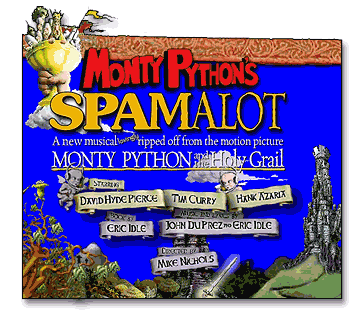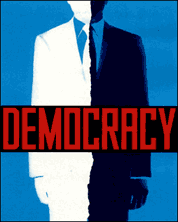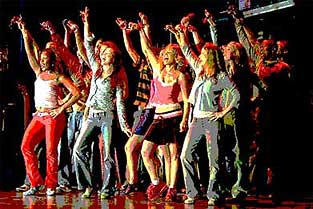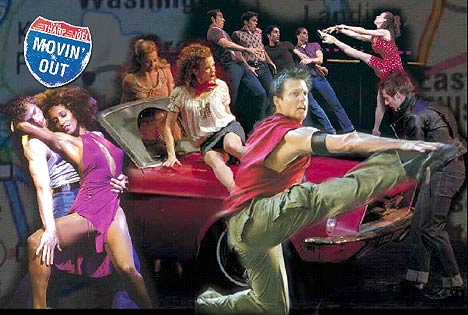 |
Please note: Performers named in these reviews may have left the show after the reviews appear on this website.

Spamalot

Eric Idle has written a new musical lovingly ripped off from the motion picture Monty Python and the Holy Grail and it is as ridiculous a piece of tomfoolery as there ever was. The minimalist plot consists of King Arthur, having found the sword Excalibur with help from the Lady of the Lake, attempting to round up enough knights to form the round table at Camelot. Along the way he is directed to find the Holy Grail or else be anihilated. But this plot is overtaken by sight gags, moving scenery, hilarious, irreverent nonsense that harkens back to the good old days of vaudeville as well as pulling from various Broadway shows in spoofing delight. The entire cast is superb beginning with Tim Curry as King Arthur of the muddled countenance, David Hyde Pierce as Sir Robin of the queasy stomach, Hank Azaria as Sir Launcelot of the uncertain gender, Christopher Sieber as Sir Galahad of the golden locks, Christian Borle as Prince Herbert the dainty and Michael McGrath as Patsy the song and dance man with the clapping coconuts. This inane sextet is complemented by Sara Ramirez as The Lady of the Lake who is at heart a Las Vegas chorine/star and a yearning bride-to-be. Mike Nichols has directed this pastiche of foolishness with help from everyone in the set design, lighting and costume business as well as John Du Prez who co-wrote the music with Eric Idle. All in all this show is a total delight.

Little Women
 Little Women has a long admired book by Louisa May Alcott and a gifted performer named Sutton Foster who does a magnificent job as Jo, the heroine of the piece. Obviously molded on Miss Alcott herself, an early proponent of feminism, this tomboy adolescent strives to find her own identity as a writer while holding together her 3 sisters during their fathers absence in the Civil War. She is abetted by Maureen McGovern as Marmee, the mother of the flock and Janet Carroll as Aunt March, the moneyed dowager aunt who often comes to the rescue of the poverty stricken family. Jenny Powers is Meg, the romantic, Megan McGinnis is the wistful Beth while Amy McAlexander is the spoiled child Amy. All perform well as do the various suitors John Hickok, Danny Gurwin and Jim Weitzer. There are some lovely ballads, i.e. “More Than I Am,” the love duet between Meg and John and “Some Things Are Meant To Be,” the duet between the doomed Beth and Jo, written by Jason Howland and Mindi Dickstein. The beautiful costumes by Catherine Zuber illuminate the period of the play. All in all this is an endearing version of a perennial classic. Little Women has a long admired book by Louisa May Alcott and a gifted performer named Sutton Foster who does a magnificent job as Jo, the heroine of the piece. Obviously molded on Miss Alcott herself, an early proponent of feminism, this tomboy adolescent strives to find her own identity as a writer while holding together her 3 sisters during their fathers absence in the Civil War. She is abetted by Maureen McGovern as Marmee, the mother of the flock and Janet Carroll as Aunt March, the moneyed dowager aunt who often comes to the rescue of the poverty stricken family. Jenny Powers is Meg, the romantic, Megan McGinnis is the wistful Beth while Amy McAlexander is the spoiled child Amy. All perform well as do the various suitors John Hickok, Danny Gurwin and Jim Weitzer. There are some lovely ballads, i.e. “More Than I Am,” the love duet between Meg and John and “Some Things Are Meant To Be,” the duet between the doomed Beth and Jo, written by Jason Howland and Mindi Dickstein. The beautiful costumes by Catherine Zuber illuminate the period of the play. All in all this is an endearing version of a perennial classic.

 Democracy Democracy
Michael Frayn's latest offering tells the story of the rise and fall of Willy Brandt, West Germany's socialist chancellor from 1969 to 1974. Was it the spy Gunter Guillaume who, despite his admiration and attachment to the chancellor, betrayed him everyday by reporting to the East German Intelligence Service who destroyed him? Was it the charismatic leader's own fondness for gambling, women and alcohol that led him down the path to failure? Was it the internecine squabling of his endless contingent of cabinet ministers who allowed their own greed and need for power to sacrifice him? Was it all of the above? James Naughton portrays Brandt in eloquent maner while Richard Thomas is at his best as the oily, unctuous, sanctimonious Guillaume. Robert Prosky and Michael Cumpsty contribute skillfully while the set design by Peter J. Davison uses various stage levels to enhance the interplay of the protagonists. This is a fascinating evening in the theater.

Brooklyn Boy
Eric Weiss (Adam Arkin), after working on a novel for 6 years, has finally made it to the best seller list even though he is only 11th in rank. But his dying father takes no joy in this, berating him for real and imagined insults throughout his life. His wife, a writer with no publications and no children is divorcing him against his wishes. His best friend from high school days insists on pointing out the absence of of practicing Judaism in his life. His Hollywood agent who deems his book magnificent is busy rewriting it so it should appear less "ethnic" in the movie version. All in all Eric's life is falling down around him and the line between success and failure becomes blurred at best.
Scenery by Ralph Funicello is excellent—both sparse and imaginative. The entire cast is more than capable of interacting with our hero in a tantalizing fashion both supporting and destroying in continuous flow. Daniel Sullivan has directed while Donald Margulies is responsible for writing this original play.

Good Vibrations
 Everyone who loves the music of Brian Wilson and The Beach Boys should see this show. Everyone who never heard of Brian Wilson and the Beach Boys should also see this show so they too can enjoy the energy, spiritidness and musicality of this production. Set somewhere in the 1960s the story follows 4 graduates of an East coast high school who make their way to California for sun, surf and fun before facing the chores of growing up. Their journey is set to the most popular Beach Boys hits, enlivened by the set designs of Heidi Ettinger and lighting design of Brian MacDevitt and Jason Lyons. David Larsen and Kate Reinders play the romantic leads quite appealingly while Jessica-Snow Wilson and Tituss Burgess lend comic relief to the secondary set of lovers. All and all this show is bursting with good will and lightheartedness guaranteed to put everyone in the audience in the best of moods. Everyone who loves the music of Brian Wilson and The Beach Boys should see this show. Everyone who never heard of Brian Wilson and the Beach Boys should also see this show so they too can enjoy the energy, spiritidness and musicality of this production. Set somewhere in the 1960s the story follows 4 graduates of an East coast high school who make their way to California for sun, surf and fun before facing the chores of growing up. Their journey is set to the most popular Beach Boys hits, enlivened by the set designs of Heidi Ettinger and lighting design of Brian MacDevitt and Jason Lyons. David Larsen and Kate Reinders play the romantic leads quite appealingly while Jessica-Snow Wilson and Tituss Burgess lend comic relief to the secondary set of lovers. All and all this show is bursting with good will and lightheartedness guaranteed to put everyone in the audience in the best of moods.

Brooklyn the Musical
If this show had opened in a small venue Off-Broadway such as those in Greenich Village, the effect would be dazzling. The scenery's a marvelous hodgepodge of ideas, the costumes are strung together with tape and consist of trashy junk found in the streets, the alleys, the dustbins etc. The inventiveness of the staging and direction are non-pareil, the music is melodious and the lyrics, if a bit banal, are passable. But this show opened on Broadway and it may be just too slight to sustain itself for long.
The plot concerns 5 street singers who present an evening's entertainment—a fairy tale to be exact. It seems a troubador from Brooklyn arrives in Paris in 1969, falls in love with a Parisienne singer, unknowingly impregnates her before being sent off to Vietnam and vanishing from her life. She names her daughter Brooklyn and teaches her the unfinished lullaby her lover has left with her. In due time mama commits suicide, daughter sets off for Brooklyn to find her daddy. In the course of looking for daddy, Brooklyn becomes involved in a contest with a street singer named Paradice. She is helped in her journey by a magical fairy godfather, also a street singer and so on.
All the singers have excellent voices particularly Eden Espinoza as Brooklyn and Cleavant Derricks as the The Street Singer. Mark Schoenfeld and Barri McPherson are responsible for the book, lyrics and music, Jeff Calhoun the direction, Ray Klausen the inventive sets and Tobin Ost the remarkable costumes.
Movin’ Out
Movin Out is a perfect amalgam of the talents of Twyla Tharp and Billy Joel. The story follows the lives of 5 friends from the early 1960s through the Vietnam War and the period of dissolution and resolution thereafter. There is no spoken dialogue other than the words of Billy Joel’s songs but they are more than sufficient to move the narrative along. And then there’s the dancing! Twyla Tharp’s choreography, particularly in the second act, shines as she captures the horrors of war, the reactive dissipation and the final release from the terror of chaos and destruction. 
All the dancers are excellent but John Selya is more than that as he flies across the stage as if with wings. Michael Cavanaugh plays piano and sings with some of Billy Joel’s styling but even more of his own while the orchestrations performed by a 10 piece band encompass the theater. This is a superb show.

Wicked
Kristin Chenoweth is the adorable popular blonde destined to be the good witch of Oz. Idina Menzel is the intelligent, gifted but green girl doomed to be the wicked witch of the West. But is there an alternative to this predestination?
Wicked purports to have the answer to this question and it does it in great style with fantastic sets designed by Eugene Lee with the special effects of Chic Silber and Paul Rubin/ZFX, Inc. Thus we have flying monkeys, giant munchkins, fiery dragons and green, green Emerald City. Joel Grey is the hapless wizard searching for answers within the ancient book of spells and rituals while Carole Shelley is the school mistress ready to supply grist for his mill. The plot has several twists and turns as the two would-be witches meet as young girls in Sorcery School and become immediate friends.
Then they both fall in love with Norbert Leo Butz and more complications arise. Although the alternative ending also encompasses the Scarecrow, the Tin Man and the Cowardly Lion it is Glinda and Elphaba who rise to the occassion with splended performances and vocalizations. The music is adequate if not memorable while the choreography is appropriate to the action.

Fiddler on the Roof
“Fiddler” remains a glorious show despite David Leveaux’s efforts to tone down some of the ethnic and religious characteristics of the original. Thus we have a minimalist setting consisting of beautiful lights and scrims that open up the small town of Anatevka into larger spaces which, while truly lovely, do not represent an impoverished village. And we have Alfred Molina playing Tevye the Everyman rather than Tevya the Dairyman minus the “yiddishkeit” in his movements and vocal timber. Despite this he gives a good, if not great, performance as does Randy Graff as his wife Golda. The daughters and their suitors are all well played, particularly Tzeitel (Sally Murphy) and Motel (a wonderfully limp noodle by the name of John Cariani ) but the heart of the evening remains the music of Jerry Bock, the lyrics of Sheldon Harnick and the magnificent dances of Jerome Robbins. They evoke the passion and eloquence in the stories of Sholom Aleichem which form the basis of this show.

Never Gonna Dance
“Never Gonna Dance” is Broadway’s version of the Fred Astaire-Ginger Rogers 1936 movie “Swing Time.” It has the beautiful music of Jerome Kern aided by lyrics by Dorothy Fields, Ira Gershwin, Johnny Mercer and others of similar caliber as well as the production dance numbers of Jerry Mitchell. Noah Racey has the Astaire role of the dancer who has to earn $20,000 in one month without dancing before his fiancé’s father will agree to the wedding. Nancy Lemenager is the dance instructress who meets Lucky as he arrives in New York to accomplish his mission. Of course the music starts as soon as they see each other and “The Way You Look Tonight” as well as “A Fine Romance” supply the background for delightful dancing. In addition to the principals we have Karen Ziemba and Peter Gerety as the secondary lovers who supply the laughs. Robin Wagner has achieved the art deco look of the thirties while William Ivey Long’s costumes amplify the mood. But it is Jerome Kern who is the true, albeit posthumous, star of the evening
.
Anna In The Tropics
Set in Florida in 1929 in a cigar factory run by Cuban immigrants who still hand roll the cigars and rely on a “lector” to break up the monotony of the job by reading novels to them this play sets up a dynamic which can only lead to explosions. The lector (Jimmy Smits) has decided to read “Anna Karenina” to the factory owner, his wife, their two daughters, one son-in-law and a half brother all of whom become inflamed by the passionate story and begin to act-out their own phantasies. Daughter Conchita (Daphne Rubin-Vega), unhappily married to Palomo (John Ortiz) who cheats on her, becomes sexually involved with the lector. The factory owner (Victor Argo), a gambler who has risked his factory is married to Ofelia (Priscilla Lopez) who is resentful about his compulsive behavior. Younger daughter Marela, a hysterical histronic teen-ager (Vanessa Aspillaga) has her own dreams which bear no relation to reality and half brother Cheche (David Zayas) is intent on both modernizing the factory and reaping vengeance on all lectors since one ran away with his wife. This muddle of misbehavior and misintentions leads to its inexorable conclusion. All the players are excellent particularly Jimmy Smits and Priscilla Lopez who catch the cadence audibly and effortlessly. Scenery by Robert Brillis is enhanced by costumes by Anita Yavich and lighting by Peter Kaczorowski
.
Cat On A Hot Tin Roof
This play seems to have had as many lives as the proverbial kitten. The current version differs from the 1955 original Elia Kazan interpretation and from the subsequent movie but is similar to the 1974 revival. In any case the main focus remains the same ie mendacity, avarice and denial with a dollop of cruelty thrown in for good measure. This Big Daddy initially does not know he is dying but he does know he can not stand his wife of many years who truly loves him, Brick can not stand his wife Maggie, blaming her for the suicide of his “spiritual” buddy Skipper rather than the repressed homosexuality which prompted it, Gooper and Mae keep having children to ensure their inheritance of Big Daddy’s fortune rather than any great love of children and so on. In this bombastic version Ashley Judd is a creditable Maggie, Jason Patric a sullen Brick and Ned Beatty a satisfying Big Daddy while Margo Martindale, Michael Mastro and Amy Hohn bring Big Mama, Gooper and Mae to life as well as the dialogue allows. The setting by Maria Bjornson befits a luxurious plantation home while Jane Greenwood’s costumes remain well within the 1950’s period.

The Boy From Oz
Although looking nothing like Peter Allen, Hugh Jackman manages to capture his charisma and zest and is perhaps even more frenetically adorable than his predecesor. In “The Boy From Oz” he rampages the stage, strutting here and there, revealing boisterous joyousness as well as pathos and pain. The play encompasses his early life in Australia, his glory days working for Judy Garland, marrying the very young Liza Minnelli and starring in Radio City as well as his lengthy relationship with his male lover and his premature death of AIDS at the age of 48. The music is basically Peter Allen’s with some assist from Carole Bayer Sager and others while the costumes of William Ivey Long recreate the principals in meticulous detail. Isabel Keating looks like Judy Garland, sounds like Judy Garland and her premature death is as poignant on stage as it was in real life. Stephanie J. Block as the young Liza Minnelli captures her breathy speech and belting voice with uncanny ease. Beth Fowler as Peter’s mother, Jarrod Emick as his lover and Mitchel David Federan as young Peter add to the proceedings but it is Hugh Jackman that gives the evening its glitter and outright enjoyment. Go see for yourself!

NINE, The Musical
“Nine”is Arthur Kopit, Maury Yeston and Mario Fratti’s musical version of Fellini’s signature film“8-1/2.” Originally produced in 1982 and staged by Tommy Tune in a modern, abstract American version the current production directed by David Leveaux has a slightly more European flavor and a lot more water! The story centers on the“genius” film maker Guido Contini who is at a crossroads. Blocked in his creativity, unable to write or produce the masterpiece he has already been paid for, he flees with his wife to a spa in Venice to recoup his strength. Unfortunately his mistress, his producer, his muse, his past assorted women, his dead mother and his nine year old self come along for the journey and bedevil him at every step. Antonio Banderas is perfect as the charismatic boy wonder, while Mary Stuart Masterson as his wife, Jane Krakowski as his nearly naked mistress who sings upside down hanging from the ceiling, Laura Benanti as his muse and Chita Rivera as his impatient producer are all more perfect than not. The entire production is glorious and makes for an enchanting evening in the theater.

Man of La Mancha
In “Man of La Mancha,” Don Miguel de Cervantes acts-out his heroic epic “Don Quixote” while awaiting his questioning by the Spanish Inquisitors in a dungeon in Seville in 1594. He is aided by his trusted servant Sancho Panza and the other prisoners in this hell hole who perform varous roles in the enactment. Brian Stokes Mitchell does a masterful job as both the agile and intellectual political prisoner and the dreamy, hallucinating idealizing Don Quixote who sets out to right all wrongs and make the world a better place. In so doing he transforms the barmaid Aldonza into the Lady Dulcinea lifting her from a life of misery and sadistic mistreatment into an honorable state. Mary Elizabeth Mastrantonio gives a virtuosa performance as the slut/lady while Ernie Sabella is truly comic as the servant who really likes his master. The set is cleverly designed to open and shut at various times revealing different locales while the costumes are appropriately tattered. Credit goes to Paul Brown for the above. The music by Mitch Leigh remains as appealing as ever.

The Play What I Wrote
“The Play What I Wrote” is a zany tribute to the comic duos of burlesque and vaudeville days such as Smith and Dale, Willie and Eugene Howard, Laurel and Hardy and of course the English duo of Morecambe and Wise. It is an evening of fun, puns, double entendres, sight gags and pure genius slapstick as Sean Foley and Hamish McColl go through their paces. They are ably aided and abetted by second banana Toby Jones who is first rate and by a mystery guest each evening culled from the likes of Kevin Kline, Nathan Lane and Roger Moore. The plot, such as it is, concerns the desire of Hamish McColl to leave the act, become a serious writer and produce his play “A Tight Squeeze for the Scarlet Pimple” on Broadway. The ensuing nonsense is ably directed by Kenneth Branagh, who proves he understands humor as well as the classics, and produced by Mike Nichols who has nothing to prove. Eddie Braben has also had a hand in writing this evening of laughter, both “audible and inaudible.”

La Boheme
Baz Luhrmann has brought opera to Broadway not with a whimper but a bang! Of course he has the most beautiful music imaginable courtesy of Giacomo Puccini who would undoubtedly be gratified to reach current mass audiences with such aplomb. Luhnnann also owes a good deal of his success to his partner Catherine Martin whose set designs excel particularly in Act 11 which reveals Paris in all its Latin Quarter glory. And then there are the singers—all young, gifted and agile who bring the characters to life with intensity and vocal dexterity. There are 3 different sets of main characters who alternate performances. They are all excellent but one most deserving of acclaim is Ekaterina Solovyeva who makes Mimi both endearing and fragile while singing with full voice. The only less than perfect concept of this production is the updating of the setting from 1830 to 1957 which makes starving poets and dying consumptives an unlikely occurence. But then opera often takes liberties with reality and this remains a truly remarkable evening in the theater.

 |
|
 |
|
|
|

